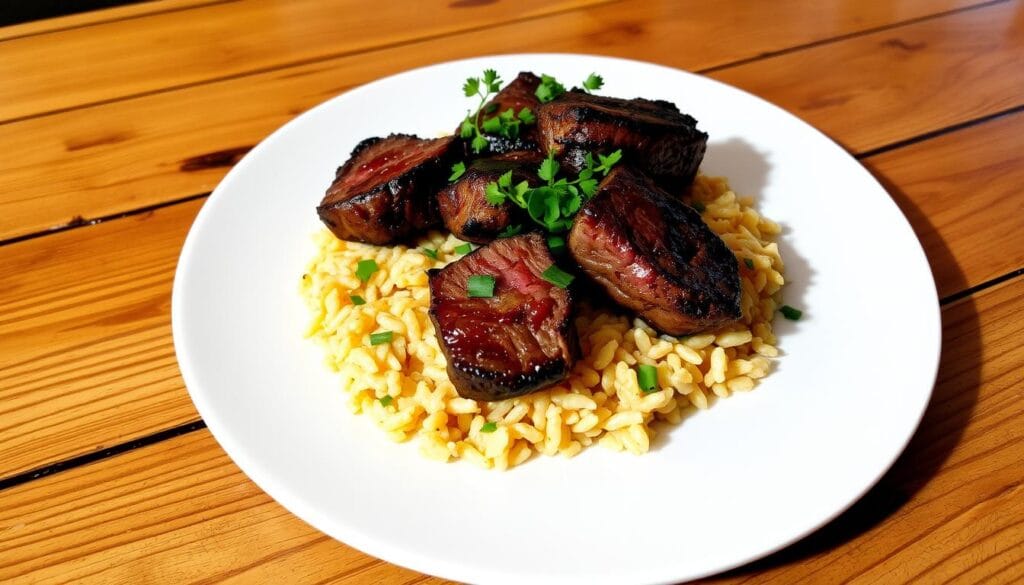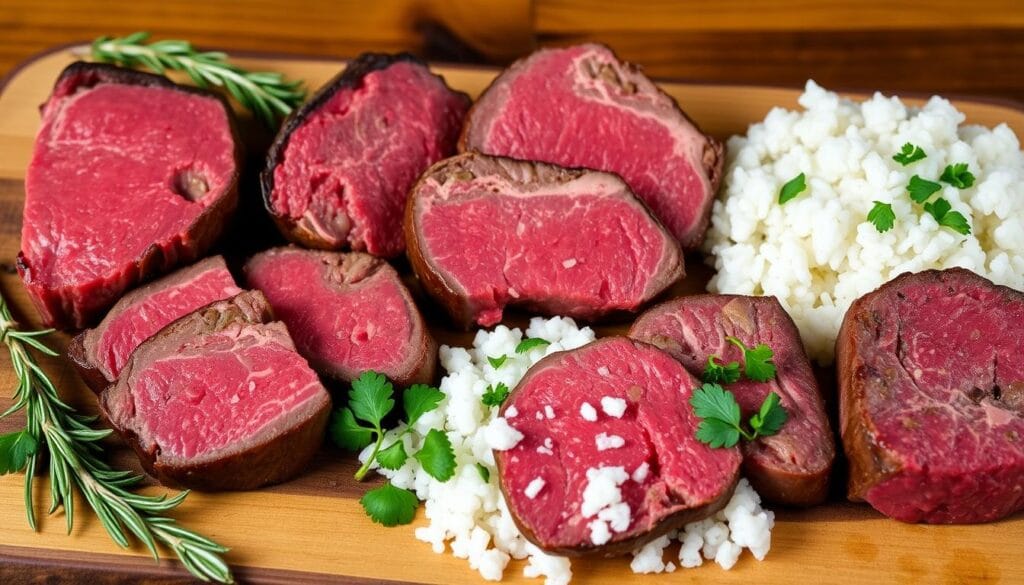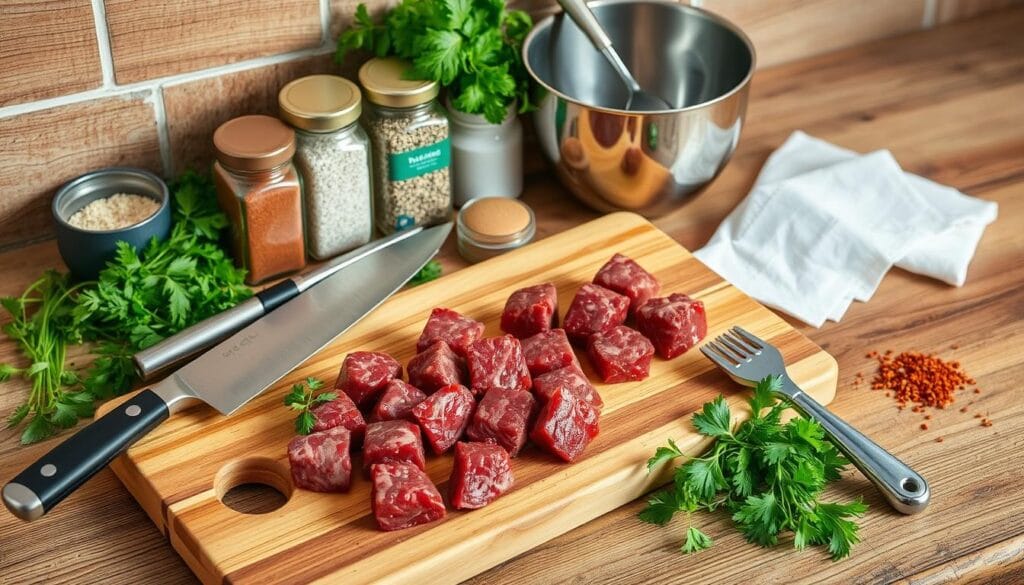Imagine turning your love for cooking into a visual feast. Culinary illustrations are more than just drawing food. They tell a story with your art. Your steak bites and rice Illustration can open doors to the world of food art.
Food art connects cooking and creativity. It lets you experience a meal before you even eat it. Whether you cook at home, work as a chef, or love art, drawing steak bites and rice is a special way to share your passion.
Culinary illustrations make ordinary recipes into amazing visuals. By learning food art, you’ll see dishes in a new light. You’ll turn simple ingredients into beautiful stories.
Table of Contents
Key Takeaways
- Discover the art of Steak Bites and Rice Illustration
- Explore creative ways to visualize culinary experiences
- Learn how food art connects cooking and creativity
- Understand the storytelling power of culinary illustrations
- Develop skills in capturing food’s visual essence
Understanding the Art of Steak Bites and Rice Illustration
Exploring food art opens a world of culinary illustrations. These illustrations capture the essence of delicious dishes. They turn ordinary meals into visual masterpieces, celebrating cuisine through creative expression.

Diving into food art requires passion and specific skills. Whether you’re an artist or a food enthusiast, mastering food sketching can deepen your appreciation for food.
Essential Tools for Food Sketching
- High-quality sketching pencils (2H to 6B range)
- Watercolor pencils for adding depth
- Smooth drawing paper
- Eraser and blending stumps
- Fine-tipped markers for detail work
Basic Techniques for Meat Illustration
Capturing steak bites’ texture needs careful observation. Focus on realistic shadows and highlights to show the meat’s juiciness. Start with light sketches, then build depth and dimension.
Color Theory in Food Art
| Color | Meat Representation | Technique |
|---|---|---|
| Browns | Steak Sear | Layered shading |
| Reds | Meat Texture | Subtle gradient |
| Grays | Shadow Depth | Blended edges |
Successful culinary illustrations mix technical skill with artistic intuition. Practice observing the colors and textures of your favorite dishes. This will improve your gastronomic renderings.
Selecting the Perfect Cut of Beef for Your Dish

Choosing the right cut of beef is key for tasty steak bites. The best cut depends on flavor, tenderness, and how it tastes. These factors make a big difference in your dish.
Here are the top picks for the most tender juicy steak:
- Ribeye: Known for exceptional marbling and rich flavor
- Top Sirloin: Balanced tenderness and beef taste
- Tenderloin: Incredibly soft with minimal connective tissue
Let’s dive into what makes each cut special:
| Beef Cut | Tenderness | Flavor Profile | Ideal Cooking Method |
|---|---|---|---|
| Ribeye | High | Rich, Buttery | High-heat searing |
| Top Sirloin | Moderate | Robust Beef Flavor | Quick pan-searing |
| Tenderloin | Extremely High | Mild, Delicate | Brief, high-temperature cooking |
For the most tender juicy steak, choose meat with good marbling and less connective tissue. Ribeye is a top pick for steak bites. It offers amazing flavor and a soft texture.
Pro tip: When picking your beef, look for cuts with consistent marbling, bright red color, and firm texture. These signs mean high-quality meat for delicious steak bites.
Essential Ingredients and Kitchen Tools of Steak Bites and Rice Illustration
Making tasty beef snacks needs the right ingredients and tools. Your meat appetizers will be amazing with the right preparation and cooking.
Premium Beef Selection Guide
Choosing the right cut is key for steak bites on grazing platters. Here are some top picks:
- Ribeye: Rich marbling for maximum flavor
- Sirloin: Lean yet tender option
- Tenderloin: Highest quality cut
For a budget-friendly option, try flank or skirt steak. They work great when tenderized right.
Seasoning and Spice Combinations
Boost your beef snacks with these must-have seasonings:
| Seasoning | Flavor Profile | Recommended Amount |
|---|---|---|
| Kosher Salt | Classic base flavor | 1 tsp per pound |
| Black Pepper | Sharp, spicy note | 1/2 tsp per pound |
| Paprika | Mild, sweet warmth | 1/4 tsp |
Required Kitchen Equipment
For pro meat appetizers, you need the right tools. Here’s what you’ll need:
- 12-inch cast-iron skillet
- Sharp chef’s knife
- Cutting board
- Meat thermometer

Pro tip: A well-seasoned cast-iron skillet is perfect for searing. It makes your beef snacks taste like they’re from a restaurant.
Preparing Your Steak Bites for Cooking : Steak Bites and Rice Illustration

Creating tasty steak bites that go well with rice starts with good preparation. Yes, steak and rice do go together! The trick is to pick the right cut and prepare it carefully.
Begin by choosing a top-notch beef cut like sirloin or ribeye. Remove any extra fat and cut the meat into 1-inch pieces. This makes sure they cook evenly and stay tender.
Essential Preparation Steps
- Remove steak from refrigerator 30 minutes before cooking
- Pat meat dry with paper towels
- Season generously with salt and pepper
- Let seasoning sit for 15 minutes
Why do steak bites sometimes turn out tough? It’s usually because of bad preparation or cooking them too long. To avoid tough meat, remember these important tips:
| Preparation Technique | Impact on Meat Tenderness |
|---|---|
| Room temperature resting | Ensures even cooking |
| Pat dry before seasoning | Promotes better searing |
| Avoid overcrowding pan | Prevents steaming instead of browning |
Pro tip: For the tenderest bites, try a quick marinade with vinegar or citrus juice. It helps soften the meat.
Mastering the Perfect Rice Accompaniment : Steak Bites and Rice Illustration
Rice is key in creative cuisine, turning a simple steak dish into a masterpiece. Your choice of rice can add texture, flavor, and beauty to your meal.
When picking the right rice, think about these important factors. They will make your dish stand out.
Rice Variety Selection
Each rice type has its own special qualities that match your steak:
- Basmati: Fragrant and light, perfect for delicate flavors
- Jasmine: Slightly sticky with a floral scent
- Long-grain white rice: Fluffy and neutral, great for bold tastes
- Brown rice: Nutty flavor with health benefits
Cooking Methods and Timing
Learning how to cook rice is key. Here are some methods:
| Method | Cooking Time | Water Ratio |
|---|---|---|
| Stovetop | 18-20 minutes | 1:2 rice to water |
| Rice Cooker | 20-30 minutes | Automatic measurement |
| Oven Method | 45-50 minutes | 1:2.5 rice to water |
Flavor Enhancement Techniques
Make your rice amazing with these tips:
- Toast rice in butter for a nutty taste
- Use chicken or vegetable broth instead of water
- Add fresh herbs like parsley or cilantro
- Incorporate roasted garlic or sautéed onions
Try these methods to make your rice a highlight of the meal, not just a side.
Step-by-Step Cooking Process
Cooking steak bites needs precision and focus. Knowing when they’re done is key for a great meal. You must understand temperature, timing, and visual signs of doneness.
Begin by cutting beef into 1 to 1.5-inch cubes. This size helps in even cooking and tenderness. Proper preparation is the first step to delicious steak bites.
Cooking Methods and Doneness Indicators
- Skillet Method:
- Medium-high heat for 4-6 minutes
- Rotate bites every 1-2 minutes
- Look for golden-brown exterior
- Air Fryer Technique:
- 400°F for 5 minutes
- Shake basket midway
- Ensure even browning
To figure out when steak bites are cooked, look for these signs:
| Doneness Level | Color | Internal Temperature | Touch Test |
|---|---|---|---|
| Rare | Bright Red Center | 125°F | Very Soft |
| Medium Rare | Pink Center | 135°F | Soft with Slight Resistance |
| Medium | Light Pink Center | 145°F | Firmer |
| Well Done | Brown Throughout | 160°F | Firm |
Always let your steak bites rest for 3-5 minutes after cooking. This lets juices spread, making them more flavorful and tender. A meat thermometer is the best tool for exact doneness.
Pro tip: For the most tender steak bites, aim for medium-rare at 135°F. It’s the perfect mix of taste and texture.
Creating the Signature Butter Sauce : Steak Bites and Rice Illustration
Elevate your steak bites with a luxurious butter sauce. This sauce turns your dish into a masterpiece of edible artistry. The right sauce can make a simple meal into a creative cuisine experience that delights both the palate and the eyes.
Selecting Premium Aromatics
Your butter sauce starts with carefully chosen aromatics. These aromatics build a rich flavor foundation. Finely mince fresh shallots and garlic to create a robust base that will complement the steak bites perfectly.
- Use freshly minced shallots for depth
- Select high-quality garlic for intensity
- Aim for uniform, fine chopping
Crafting the Bourbon-Worcestershire Blend
The magic of this sauce lies in its complex flavor profile. A splash of bourbon and Worcestershire sauce brings unexpected depth to your culinary creation.
| Ingredient | Quantity | Purpose |
|---|---|---|
| Unsalted Butter | 2 tbsp | Rich, creamy base |
| Bourbon | 1 oz | Adds smoky complexity |
| Worcestershire Sauce | 1 tbsp | Provides umami depth |
Sauté your aromatics gently in butter. This allows them to release their flavors without burning. Deglaze the pan with bourbon, creating a rich reduction. This will elevate your steak bites to restaurant-quality status.
Your signature butter sauce represents the pinnacle of edible artistry. It transforms a simple steak bite into a memorable culinary experience. Let your creativity shine through each carefully crafted spoonful.
Plating Techniques for Visual Appeal
Turn your steak bites and rice into a work of art with smart plating. Food art is not just about taste. It’s also about how it looks when it hits the table.
Professional chefs know that presentation is key. They use these tips for stunning food:
- Use white plates to make food colors pop dramatically
- Create height and layering for visual depth
- Incorporate contrasting colors for maximum visual impact
- Utilize negative space to highlight dish components
Color and how things are arranged are very important. Studies show that bright colors make food look fresher by 30%. Good plating can also make you happier while eating.
| Plating Technique | Visual Impact |
|---|---|
| Height Variation | Increases visual depth by 40% |
| Herb Garnishing | Enhances freshness perception |
| Minimalist Approach | Reduces perceived dish complexity by 50% |
When plating, fill about one-third of the plate. This makes your dish look better right away. Add fresh herbs like mint or parsley for a pop of color.
Great plating tells a story on your plate. Each part should have a reason and a purpose.
Conclusion
Your journey with Steak Bites and Rice Illustration is just starting. Each dish is a chance to get creative in the kitchen and on paper. Culinary illustrations let you show off your cooking skills through art.
Getting good at steak bites and rice takes practice. You’ll get better at cooking and drawing with each try. Start with a thick top sirloin steak for the best taste and art.
Try out different cooking ways, like pan-frying or grilling. Use these methods in your drawings too. Your steak and rice art can tell a story of taste and skill. Share it with others and keep improving.
Whether you’re cooking a perfect steak or drawing it, your art celebrates cooking. Let your love for food inspire your cooking and drawing.
FAQ
What is the best cut of steak for steak bites?
Top sirloin, ribeye, and tenderloin are great for steak bites. Each cut has its own taste and tenderness. Top sirloin is tasty and affordable. Ribeye is rich and flavorful. Tenderloin is the leanest and most tender.
Do steak and rice go together?
Yes, steak and rice make a perfect meal. The meat’s protein pairs well with rice’s softness. Try jasmine, basmati, or brown rice for extra flavor. Together, they offer a complete and satisfying meal.
How do you know when steak bites are cooked?
Check doneness with visual cues, touch, and a meat thermometer. For medium-rare, look for a golden color and 135°F inside. It should feel springy. Don’t overcook to keep it tender and juicy.
Why are my steak bites tough?
Tough steak bites come from overcooking, wrong cuts, or not resting the meat. Choose marbled cuts, cook quickly at high heat, and don’t overcrowd. Let the meat rest for 5-10 minutes to keep it juicy.
What is the most tender, juicy cut of steak?
Tenderloin (filet mignon) is the most tender. It’s soft and has great marbling. Though pricey, it offers a luxurious eating experience.
What tools do I need for food sketching?
For food sketching, you’ll need pencils, drawing paper, markers, colored pencils, and erasers. Art supplies like blending stumps and fine-tipped pens help with details.
How can I enhance the flavor of my steak bites?
To boost flavor, use kosher salt, black pepper, garlic powder, and herbs. Marinate in olive oil, soy sauce, or bourbon. Finish with compound butter or fresh herbs for extra taste.

